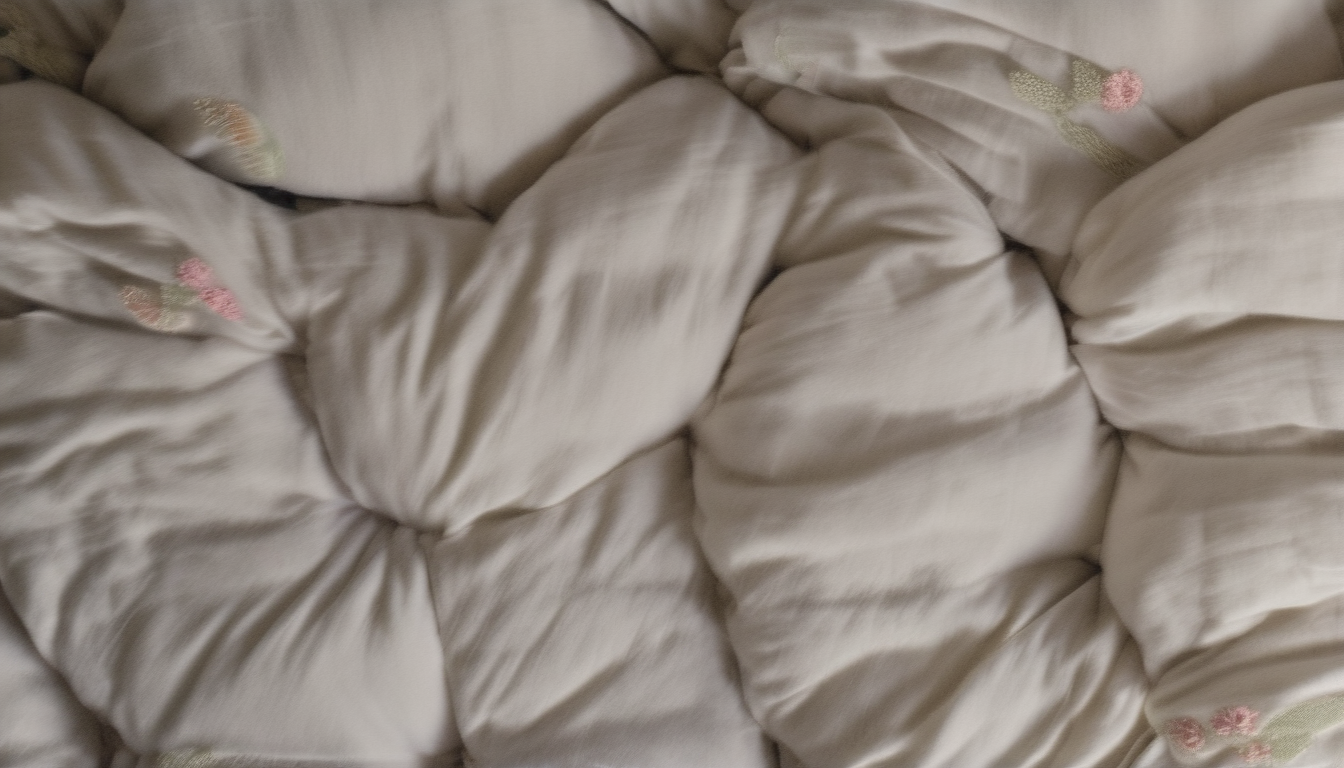Down comforters are known for providing the ultimate warmth and comfort for sleep, but how safe are they really? This basic guide covers everything a beginner needs to know.
What is Down and How Are Down Comforters Made?
Down material comes from geese and ducks. It refers to the soft, fluffy clusters of feathers closest to the bird’s skin that help provide insulation from the cold. Down feathers are light, airy, and exceptionally warm for their weight.
- Down comforters are filled with these down feathers collected from birds.
- High-quality comforters use densely-packed down sourced from mature birds.
- Baffles or compartments in the shell keep the feathers evenly distributed.
- Comforters have different fill powers indicating the volume of space covered by an ounce of down (typically 600-800 fill power).
The Pros of Down Comforters
Down comforters provide incredible benefits, including:
- Unmatched warmth: Down naturally traps heat extremely well creating a cozy night’s sleep.
- Lightweight and breathable: The filling is very light allowing easy temperature regulation.
- Lasts years: With proper care a quality down comforter can last over a decade.
- Improves sleep quality: The softness and warmth leads to deeper REM sleep cycles.
- Reduces anxiety: The weighted feeling offers a sense of calming comfort for many people.
Health and Hypoallergenic Concerns with Feathers
While the benefits are clear, down does come with some health concerns to be aware of:
Allergy and Asthma Triggers
The proteins in feathers often trigger allergic reactions for sensitive people leading to issues like:
- Sneezing, runny nose
- Wheezing, chest tightness
- Itchy, watery eyes
- Hives, eczema flare ups
Around 3% of adults have a feather allergy. Those with asthma can also react to particles entering the lungs.
Hypersensitivity Pneumonitis
A more severe reaction is hypersensitivity pneumonitis (HP). This inflammation of lung tissue results from repeated exposures to organic dusts from birds. Symptoms include:
- Fever, chills
- Breathing difficulty
- Chronic dry cough
It’s onset is typically slower, occurring over weeks or months.
Long Term Effects
The worst case scenario is called “feather lung” or pulmonary fibrosis. The prolonged exposure to feather proteins leads to permanent lung scarring and reduced oxygenation.
Dust Mites Concerns
Feathers also tend to accumulate dust mites and skin flakes over time. This introduces new allergen sources.
Mitigating Health Risks of Feathers

- Allergen-proof covers: Encase comforters in dust mite blocking fabric.
- Hot water washing: Frequently wash comforters on hot to kill mites.
- Vacuum w/ HEPA filter: Use special vacuum attachments to remove particles.
- Air purifiers: Position units near the bed to filter airborne allergens.
Proper use of duvet covers, comforter cleaning, humidity control and other steps also help. Those with moderate to severe feather allergies may still need to avoid down bedding altogether, unfortunately.
Finding Hypoallergenic Down Alternatives
For those with frustrating feather allergies, there are a few down alternative options to consider:
Synthetic Fill: Polyester fibers mimic down’s ultra-soft feel without allergens.
Cotton: Natural cotton batting is breathable, hypoallergenic and easily washed.
Silk: Silk fibers regulate temperature well and are smooth against the skin.
| Fill Material | Price | Pros | Cons |
|---|---|---|---|
| Polyester | $ | Inexpensive, easy to clean | Less warmth, durability |
| Cotton | $$ | Natural, breathable | Needs fluffing |
| Silk | $$$ | Smooth, temperature regulating | Expensive, high maintenance |
While alternatives work for some, many people still prefer natural down’s unmatched coziness. Using protective covers and washing frequently can allow enjoying feather bedding more safely.
The Environmental Impact of Feather Harvesting
Down production isn’t without environmental considerations either regarding animal welfare and water waste:
- Live plucking: Unethical practice still used in some regions. Opt for “responsible down” sources instead.
- Chemical processing: Harsh bleach and detergents are used to clean feathers which then enter waterways.
- Alternatives: Choose plant-based fills like kapok for lower impact options.
Making informed choices is key to finding an environmentally responsible down comforter brand. Refer to certifications like the Responsible Down Standard (RDS) when buying.
Caring for a Down Comforter

Follow these tips to keep a feather comforter in great shape for years:
1. Use a Duvet Cover
Protect the comforter from body oils and spills. Duvet covers allow easy cleaning.
2. Air Out Regularly
Hang outdoors or drape over furniture to replump flattened areas.
3. Wash Every 6 Months
Use a large capacity machines to clean thoroughly with mild detergent.
4. Dry Completely
Make sure no moisture remains or mold can grow inside.
5. Store Properly
Keep comforters in breathable cotton cases during warmer months.
With some basic care, a quality down comforter should last over a decade before needing replacement!
Special Considerations for Babies and Small Children
It’s critical to avoid feather bedding for infants under 12 months:
- Loose comforters in the crib increase the risk of sudden infant death syndrome (SIDS).
- Baby’s loose bedding also heightens the chances of accidental suffocation.
Likewise, feathers can irritate young skin. Many pediatricians recommend avoiding down comforters until children are school-aged. Use lightweight cotton blankets or special wearable blankets called sleep sacks for optimal safety and temperature regulation.
Key Takeaways on Down Comforters
- Down comforters provide exceptional softness, durability and warmth unmatched by synthetics.
- Health risks like allergies, asthma and hypersensitivity pneumonitis do exist, especially with repeated exposure. Use covers and clean regularly.
- Those with moderate to severe feather allergies may need to avoid down altogether and choose hypoallergenic alternatives instead.
- Make educated choices and care properly for these luxury bedding items to enjoy their benefits. Avoid for babies and young toddlers.
Hopefully this beginner’s guide gave you all the basic information on the pros, cons, alternatives and proper handling of down comforters. Stay cozy and sleep well!
Frequently Asked Questions
Are down comforters better than synthetic alternatives?
Yes, down comforters provide more warmth for their lightweight than any synthetic like polyester or microfiber. The clusters of down feathers form tiny air pockets that slow heat transfer exceptionally well to regulate body temperature. The fluffiness also compresses well for a cozy, cushiony feel.
How often should you wash a down comforter?
Wash down comforters at least every 6 months. The feathers and fill power may get flattened with regular use. Frequent hot water washing kills dust mites and removes body oils, allergens and debris. Make sure to completely dry comforters to avoid potential mold issues.
Can you put a down comforter in the dryer?
Yes, you can dry clean or machine dry down comforters on a low, delicate setting. Make sure to use wool dryer balls or tennis balls to fluff the feathers back up. Air drying works well also. The key is making sure all inner moisture is removed to prevent mildew.
What is the best alternative filling to feather down?
For those with frustrating feather allergies, the best down alternative fills are polyester and silk fibers. Polyester provides affordable warmth while silk offers ultra-smooth, temperature regulating properties. Cotton and wool fills are other natural options but may need more fluffing.
Can you put a down-alternative comforter in the dryer?
Yes, down alternative comforters filled with polyester or other hypoallergenic synthetic fibers are fully machine washable and dryable. Use low heat and dry thoroughly until all inner moisture is eliminated.
Are down comforters safe for babies?
No, pediatricians recommend no loose bedding like comforters for babies under 12 months. The SIDS risks and potential to restrict oxygen are too high. Use lightweight swaddle blankets or wearable sleep sacks instead. Even for toddlers, down bedding can irritate sensitive skin. Wait until children are older before introducing feather bedding.
How long should a quality down comforter last?
With proper maintenance like using a duvet cover and washing every 6 months, a high fill power down comforter should last over a decade, some even 20 years. The keys are keeping the feathers debris and moisture-free in breathable storage when not in use to prevent dust mites or mildew buildup.








